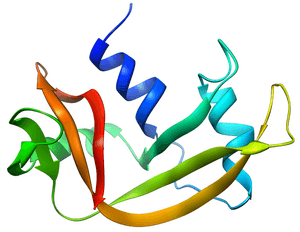Ribonuclease facts for kids
Ribonuclease (often called RNase) is a special type of enzyme. Think of enzymes as tiny workers in your body. RNases have a very important job: they cut and break down RNA molecules. RNA is like a messenger or a blueprint inside cells, carrying instructions for making proteins.
There are many different kinds of RNases. Each one is designed to cut RNA in a specific way. These enzymes are found in all living things, from tiny bacteria to humans. This shows just how important RNases are for life!
Contents
Why are RNases Important?
RNases play several key roles in cells. They help keep cells healthy and protect them from harm. Here are some of their main jobs:
Cleaning Up and Recycling RNA
Cells are always busy making new RNA molecules. But sometimes, RNA is no longer needed. It might be old, damaged, or just finished its job. RNases act like a clean-up crew. They break down this unwanted RNA into smaller pieces. These smaller pieces can then be recycled by the cell to make new RNA or other important molecules. This process helps keep the cell tidy and efficient.
Fighting Off Viruses
Our bodies are constantly under attack from tiny invaders like viruses. Many viruses, especially RNA viruses, use RNA as their genetic material. This means they use RNA to make copies of themselves inside our cells. RNases are a first line of defense against these viruses. They can recognize and destroy viral RNA, stopping the virus from spreading and making us sick. It's like having a tiny security guard inside your cells!
Controlling Genes with RNA Interference
RNases are also involved in a fascinating process called RNA interference (RNAi). This is a natural way cells control which genes are turned on or off. Imagine genes as instructions for building different parts of a cell. Sometimes, a cell needs to turn down or silence a specific gene.
In RNA interference, special RNA molecules work with RNases to block the instructions from certain genes. This stops the cell from making a particular protein. It's like putting a mute button on a gene. This process is very important for normal cell development and for fighting diseases.
In 2006, two scientists named Andrew Fire and Craig Mello won the Nobel Prize in Physiology or Medicine. They received this award for their amazing discovery of how RNA interference works. Their work helped us understand a lot more about how genes are controlled in living things.
See also
 In Spanish: Ribonucleasa para niños
In Spanish: Ribonucleasa para niños


